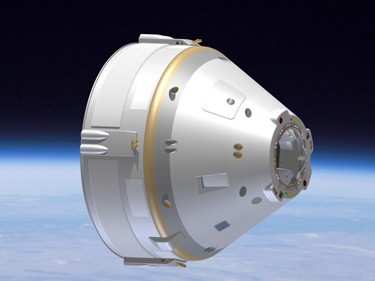Wed, Dec 15, 2010
Spacecraft Resembles Apollo Configuration With Crew And Service
Modules
Boeing has pulled the trigger on its proposal for the second
round of NASA's Commercial Crew Development (CCDev) program. The
company plans to advance the design of its Crew Space
Transportation (CST)-100 spacecraft and Commercial Crew
Transportation System and continue to demonstrate key
technologies.

Boeing Commercial Crew Concept
"In the same way that Boeing helped launch commercial aviation
more than 80 years ago, we are working to develop what could become
a true commercial space transportation system: a commercial service
to take people to the International Space Station and other Low
Earth Orbit destinations," said Brewster Shaw, Boeing Space
Exploration vice president and general manager. "We plan to further
mature our design and continue the development process toward our
first crewed flight in 2015."
The proposal is for an approach that will significantly mature
the CST-100 design through demonstrations of critical subsystems.
The CST-100 spacecraft is designed to support NASA's primary
objective of affordable access to Low Earth Orbit. It will carry up
to seven crew and passengers, is reusable up to 10 times, and is
compatible with a variety of expendable launch vehicles. The
spacecraft -- which is comprised of a Crew Module and a Service
Module -- draws on Apollo-proven aerodynamic characteristics in a
design that uses commercial, off-the-shelf, cost-effective
technologies.

In October, Boeing completed a Systems Definition Review with
NASA that defined the CST-100 spacecraft's system characteristics
and configuration and established a baseline design. Other major
accomplishments of the first round include:
- Design, build and test of a pressurized structure of the crew
module
- Creation of a mock-up of the spacecraft to ensure the crew can
enter and exit the vehicle safely, reach control switches and
easily see through windows
- Demonstration of manufacturability of the base heat shield
structure and thermal protection system to protect the crew during
re-entry into Earth's atmosphere
- Development of an avionics systems integration facility to
support rapid prototyping and full-scale development
- Development of a rendezvous sensor and associated guidance and
navigation software that allows the vehicle to autonomously
approach and dock with the International Space Station and the
planned Bigelow Orbital Space Complex
- Demonstration of airbag land landing, water landing, post-water
landing uprighting and life-support systems.
"We look forward to continuing our joint efforts with NASA to
ensure CCDev's success," said Shaw. "Enabling commercial-crew
access to Low Earth Orbit allows NASA to focus on deep space
exploration and thereby ensure a continued leadership role for the
U.S. in human spaceflight for generations to come."
More News
He Attempted To Restart The Engine Three Times. On The Third Restart Attempt, He Noticed That Flames Were Coming Out From The Right Wing Near The Fuel Cap Analysis: The pilot repor>[...]
Make Sure You NEVER Miss A New Story From Aero-News Network Do you ever feel like you never see posts from a certain person or page on Facebook or Instagram? Here’s how you c>[...]
From 2009 (YouTube Edition): Leading Air Show Performers Give Their Best Advice for Newcomers On December 6th through December 9th, the Paris Las Vegas Hotel hosted over 1,500 air >[...]
Aero Linx: NASA ASRS ASRS captures confidential reports, analyzes the resulting aviation safety data, and disseminates vital information to the aviation community. The ASRS is an i>[...]
“For our inaugural Pylon Racing Seminar in Roswell, we were thrilled to certify 60 pilots across our six closed-course pylon race classes. Not only did this year’s PRS >[...]
 NTSB Final Report: Rutan Long-EZ
NTSB Final Report: Rutan Long-EZ ANN FAQ: Turn On Post Notifications
ANN FAQ: Turn On Post Notifications Classic Aero-TV: ICAS Perspectives - Advice for New Air Show Performers
Classic Aero-TV: ICAS Perspectives - Advice for New Air Show Performers ANN's Daily Aero-Linx (06.28.25)
ANN's Daily Aero-Linx (06.28.25) Aero-News: Quote of the Day (06.28.25)
Aero-News: Quote of the Day (06.28.25)




